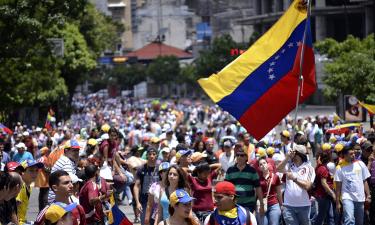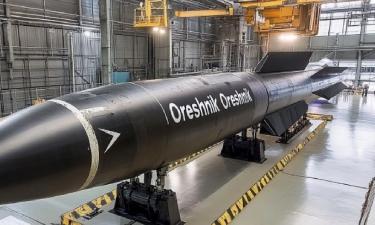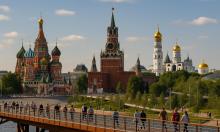Russian photo reporter Andrei Stenin killed in Ukraine
Russian photographer Andrey Stenin, who went to Ukraine at the editorial assignment of news agency Rossiya Segodnya (Russia Today), was killed. Genetic analysis confirmed that the remains of the body that militia found on August 21 near the town of Snezhnoye, the Donetsk region, belonged to Stenin.

"Our colleague, photojournalist Andrei Stenin is dead. It turned out he had not been captivated. As it turned out, they did not intend to either exchange him for someone from the Ukrainian military or accuse him of terrorist activities. All the statements about Stenin's fate that we have heard from the Ukrainian side, were lies. He died a month ago in the car, which he was driving to do his job. The car was shot at and burned on a highway near Donetsk," said General Director of MIA Rossiya Segodnya Dmitry Kiselev.
Earlier, Deputy Prime Minister of the self-proclaimed People's Republic of Donetsk, Andrei Purgin, said that he had doubts about the fact that the human remains found in the car not far from the town of Snezhnoye were the remains of missing photo reporter Stenin.
The information about the discovery of a Renault Logan car with the bodies of three people inside appeared on August 22. The car was found on a highway between the towns of Snezhnoye and Dmitrovka, among other destroyed and burned vehicles.
Stenin, who was working in the area of the combat zone in the east of Ukraine, disappeared on August 5. It was reported that he might have been detained by Ukrainian security forces, but Kiev did not confirm that.
Stenin was an experienced military photojournalist. He worked at RIA Novosti, on the basis of which MIA Rossiya Segodnya was then established. He has visited such hotspots as Egypt, Syria and other troubled locations. He was born on December 22, 1980 in the Komi Republic of the Russian Federation, in the city of Pechora. He worked as a correspondent for such publications as the Rossiyskaya Gazeta, Gazeta.Ru and freelanced for ITAR-TASS, RIA Novosti, Kommersant, Reuters, the Associated Press, France Press.
In 2009, he became a photographer for RIA Novosti. In 2014, Stenin was employed as a special photographer for the Joint Directorate of Photographic Information of MIA Rossiya Segodnya. He won "Silver Camera" prize in 2010 and 2013.
"He had no children. He was not married either. He is survived only by his mother, who was waiting for the news about her son during all this time, like we all were - the whole journalistic community of the country. We asked international organizations to help us release him. We are grateful to everyone in Russia and abroad for their actions and support. Unfortunately, when we were all trying to do everything possible and impossible to save him, Andrei was no longer alive," said General Director of Rossiya Segodnya, Dmitry Kiselev.
"In mere months, Ukraine has become the most dangerous place for journalists on Earth. This war has claimed the lives of four Russian journalists: correspondent Igor Kornelyuk, video engineer Anton Voloshin, cameraman Anatoly Klyan, photographer Andrei Sten...We will never forget him," said Dmitry Kisilev.
Journalists, working in the area of armed conflicts, are protected by Article 79 of the First Additional Protocol to the Geneva Conventions. Ukraine ratified the document on 25 January 1990. A media representative shall be deprived of the right for protection in case he or she takes arms and becomes a member of an armed conflict.
Official representative of the Investigative Committee of the Russian Federation, Vladimir Markin, said that investigators established circumstances of the death of the journalist. "On August 5, being on a business trip in Ukraine, Stenin was staying in the town of Snezhnoye. In the evening of August 6, he was driving a Renault Logan in a convoy of refugees, traveling on the road between Snezhnoye and Dmitrovka. Six militiamen were guarding the column. To the north-west of the village of Dmitrovka, the Ukrainian army, presumably, the 79th airmobile brigade, opened fire on the column from a BMP-2 and a tank," he said.
"As a result of the attack, more than ten vehicles with civilians were destroyed. Several people managed to escape and hide in roadside bushes. The next day, commanders of the Ukrainian army arrived to the site of the attack of the column. According to eyewitnesses, they examined the destroyed vehicles, searched the bodies of the killed people and loaded things from the destroyed vehicles to their transport. After they left, the territory, on which the destroyed column of refugees was located, was shelled from multiple rocket launchers Grad," Markin said.
According to Markin, on August 27, militiamen delivered a bag containing fragments of charred remains of five human bodies that were found in the destroyed Renault Logan vehicle. After that, experts established that one of the dead was Andrei Stenin.
Andrei Stenin will be buried on September 5 in Moscow.
Pravda.Ru
Subscribe to Pravda.Ru Telegram channel, Facebook, RSS!




